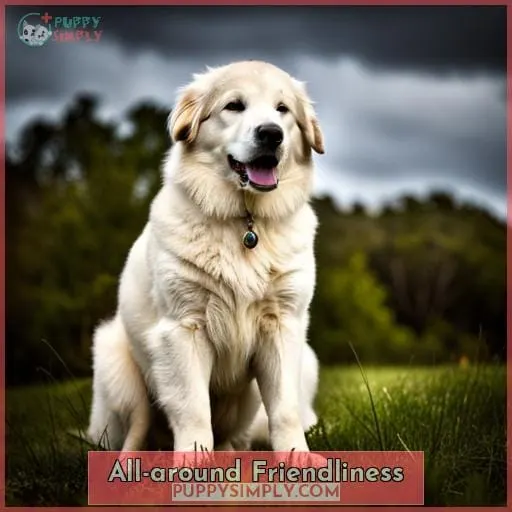This site is supported by our readers. We may earn a commission, at no cost to you, if you purchase through links.
 Imagine having a loyal companion by your side, always ready to protect and love you. That’s the Great Pyrenees dog breed for you! From their majestic appearance to their gentle temperament, these dogs are truly remarkable.
Imagine having a loyal companion by your side, always ready to protect and love you. That’s the Great Pyrenees dog breed for you! From their majestic appearance to their gentle temperament, these dogs are truly remarkable.
In this article, we’ll dive into everything you need to know about caring for and training a Great Pyrenees. From health considerations to grooming tips and training techniques, get ready to embark on an incredible journey with your furry friend.
Let’s explore the world of Great Pyrenees together!
Table Of Contents
- Key Takeaways
- Quick Facts
- Great Pyrenees Pictures
- Factors to Consider for Apartment Living
- All-around Friendliness
- How to Assess a Dog’s Compatibility With Families
- Raising a Dog-friendly Great Pyrenees
- Health and Grooming Needs
- Training Tips for Great Pyrenees
- Considerations for Pet Parents
- Similar Breeds
- Frequently Asked Questions (FAQs)
- Conclusion
Key Takeaways
- Great Pyrenees are a large breed that may not be suitable for apartment living.
- It is important to assess a dog’s compatibility with families before bringing a Great Pyrenees home.
- Great Pyrenees require regular grooming and have specific health and grooming needs.
- Training and socialization are important for Great Pyrenees, and there are fun activities that can be done with them.
Quick Facts
Known as the gentle giant, the Great Pyrenees is a large dog breed with a double coat that sheds year-round and seasonally. They’ve minimal drooling. While gentle and calm, they’re independent thinkers and can be expensive to care for properly.
Originally bred as guardian livestock dogs in the Pyrenees Mountains, they still exhibit natural guarding instincts today. Reaching 25-32 inches tall and 85-120 pounds, the Great Pyrenees is classified as a giant dog breed.
Despite their imposing size, Great Pyrenees dogs are elegant, loyal, and make devoted companions when provided with proper training and socialization. This independent and sometimes stubborn breed thrives when given a job to do and quality time with their family.
Great Pyrenees Pictures
Take a look at some adorable pictures of Great Pyrenees dogs. Their beautiful white coats make them look so fluffy and majestic.
You’ll see Great Pyrenees puppies looking cute and playful as well as adult dogs appearing loyal and gentle.
Photos often capture their friendly nature and soft expressions on their sweet faces.
Whether playing in the snow or relaxing inside, Great Pyrenees pictures showcase these large yet graceful dogs and their gorgeous white and gray coats with tan markings.
Images of Great Pyrenees highlight their affectionate personalities that make them wonderful companions.
Looking through these cute and heartwarming Great Pyrenees dog photos will make you want one of these gentle giants for yourself.
Factors to Consider for Apartment Living
When considering apartment living for a Great Pyrenees, there are several factors to take into account.
First and foremost is the size of the dog and the space available in your apartment. Great Pyrenees are large dogs that require ample room to move around comfortably.
Additionally, their exercise and activity needs must be met through daily walks or access to a secure outdoor area for them to roam.
Lastly, it’s important to prioritize their health and wellness by ensuring they receive regular veterinary care and have proper ventilation in your apartment space.
Size and Space:
Considering the size and space requirements is essential when determining whether a Great Pyrenees would be suitable for apartment living.
Here are four factors to consider:
- Great Pyrenees are large, but not too big for apartments.
- They shed a lot, but their loyalty makes it worth it.
- They’re independent, yet loyal companions.
- While they’re good with kids, resource guarding should be watched for.
Exercise and Activity:
If you live in an apartment, it’s important to consider the Great Pyrenees’ exercise and activity needs.
The breed has high energy and needs lots of exercise, loving to run, hike, and play fetch.
A fenced yard to run and play is ideal, since they can be destructive if not given enough exercise.
They’re also prone to obesity if not provided adequate physical activity.
Daily walks and playtime are essential for a cooped-up Pyrenees.
Health and Wellness
Evaluate your Great Pyrenees’ health risks before bringing one home, as their large size makes them prone to joint issues like hip and elbow dysplasia.
- Sensitive stomachs and resource guarding around food
- Heavy shedding twice a year
- High energy level and difficult housetraining
Health checks should include ear infections, nutrition needs, teeth brushing, and nail trimming.
All-around Friendliness
Your Pyr’s calm demeanor and protective loyalty breed all-around friendliness.
Known for their gentle, cuddly nature, Great Pyrenees are loyal companions and guardians.
Despite their large size, they’re remarkably gentle and playful with children when socialized early.
With their profound devotion and intelligence, Pyrs will protect little ones as their own.
Their calm presence also allows them to get along with other household pets.
However, their strong guarding instincts mean they should be monitored around small animals.
Originally bred as livestock guardians, Pyrs will graciously accept other animals they’re raised with.
While wary of strangers, these gentle giants are sweet and affectionate with their families.
Socialization and training are key for Pyrs to properly channel their protective instincts.
But their noble spirit makes them wonderful additions to any home.
How to Assess a Dog’s Compatibility With Families
You’ll want to look at several factors when determining if a Great Pyrenees is right for your family.
- Energy level: Great Pyrenees are high-energy dogs that need a lot of exercise.
- Exercise needs: They need at least two hours of exercise per day, and they’ll appreciate having a yard to run in.
- Separation anxiety: Great Pyrenees can be prone to separation anxiety, so it’s important to make sure they’ve plenty of toys and activities to keep them occupied when you’re not home.
- Destructive behavior: Great Pyrenees can be destructive if they’re bored, so it’s important to make sure they’ve plenty of things to do.
- Shedding: Great Pyrenees shed a lot, so it’s important to be prepared for that.
- Grooming needs: Great Pyrenees need to be brushed regularly to prevent matting.
- Cost: Great Pyrenees are a relatively expensive breed to own, due to their size and the cost of their food and grooming.
- Vet bills: Great Pyrenees can be prone to certain health problems, so it’s important to be prepared for the cost of veterinary care.
- Socialization and training: Great Pyrenees are independent thinkers, so they need early socialization and training to be well-behaved.
- Diet: Great Pyrenees need a high-quality diet to stay healthy.
- Breed: Great Pyrenees are a large breed of dog, so it’s important to make sure you have the space for one.
Raising a Dog-friendly Great Pyrenees
You’ll be spooning with your giant fluff ball and watching your Pyr pretend to bite the new puppy.
- Great Pyrenees are gentle, affectionate dogs.
- They’re good with children and other animals.
- They make great indoor companions.
- They’re low-maintenance dogs.
- Great Pyrenees can be expensive to own.
- They’re prone to certain health problems.
- They can be stubborn and independent.
- They may shed a lot. Final verdict: Great Pyrenees are great dogs for people who are looking for a gentle, affectionate companion. They’re low-maintenance dogs that make great indoor companions. However, they can be expensive to own and are prone to certain health problems.
Health and Grooming Needs
Great Pyrenees are prone to certain health problems, such as hip dysplasia and osteosarcoma.
They also shed heavily and require regular grooming.
To keep your Great Pyrenees healthy and happy, be sure to:
- Take them to the vet for regular checkups.
- Feed them a healthy diet.
- Brush their fur regularly.
Common Health Issues
Raising a dog-friendly Great Pyrenees requires attention to their common health issues and grooming needs.
- Hip dysplasia, a condition where the hip joint doesn’t develop properly and can lead to pain and mobility issues.
- Osteosarcoma, a type of bone cancer that commonly affects large breeds like the Great Pyrenees.
- Elbow dysplasia, which is characterized by abnormal development in the elbow joint leading to lameness and arthritis later in life.
Additionally, patellar luxation (knee cap dislocation) and Addison’s disease (adrenal gland dysfunction) can also occur in this breed.
Grooming Tips
When it comes to grooming your Great Pyrenees, regular maintenance is key in keeping their beautiful coat healthy and free from tangles.
To keep your dog looking its best, make sure to:
- Brush them at least once a week to remove any loose hair and prevent matting.
- Bathe them every 3-6 months if they’re kept indoors.
- Clip their nails and clean their ears regularly for optimal health.
Training Tips for Great Pyrenees
When it comes to training your Great Pyrenees, understanding their personality and temperament is key.
They’re independent thinkers but respond well to positive reinforcement techniques.
In addition to basic obedience training, engaging in fun activities with your Great Pyrenees can help keep them mentally stimulated and physically active.
Personality and Temperament
Great Pyrenees are independent thinkers and will obey you if they think that’s the best decision for them in the moment.
They’re also loyal, protective, and gentle giants who make great companions for people who are looking for a calm, affectionate dog.
Behavior and Training Techniques
With their calm temperament and gentle nature, Great Pyrenees are easy to train with positive reinforcement and early socialization.
Here are 4 training tips for your Great Pyrenees:
- Crate train your Pyr to help with housebreaking and separation anxiety.
- Manage food aggression by feeding your Pyr in a calm environment and never allowing them to guard their food.
- Stop play biting by redirecting your Pyr’s attention to a toy or by teaching them the leave it command.
- Teach your Pyr recall by using positive reinforcement and plenty of practice.
Fun Activities for Great Pyrenees
You will have plenty of fun activities to do with your Great Pyrenees, including:
- Obedience training
- Agility training
- Playing fetch
These activities not only provide mental stimulation for your dog but also help build a strong bond between you and your furry companion.
Additionally, swimming can be a great way to keep your Great Pyrenees physically active while providing relief from hot weather.
Hiking is another fantastic activity that allows both you and your dog to enjoy the great outdoors together.
Lastly, playing tug-of-war can be an excellent form of exercise and a fun way to engage in interactive play with your Great Pyrenees while reinforcing their training skills.
Considerations for Pet Parents
When considering a Great Pyrenees as a pet, there are several important factors to keep in mind.
Firstly, these dogs can be prone to certain health risks and concerns such as hip dysplasia and gastric torsion.
Additionally, their grooming needs shouldn’t be underestimated due to their double-layered coat that requires regular brushing.
Lastly, socialization and training from an early age are crucial for this breed’s well-being and behavior development.
Health risks and concerns
As a pet parent, it’s important to regularly monitor the health of your Great Pyrenees as they can be prone to certain health conditions.
Some common concerns include:
- Elbow dysplasia
- Bloat (gastric torsion)
- Cancer
Elbow dysplasia is a developmental condition that affects the bones in the front legs, leading to lameness and pain.
Bloat is a life-threatening condition where the stomach fills with gas or fluid and twists upon itself.
Cancer can also affect Great Pyrenees dogs, so it’s crucial to stay vigilant for any signs or symptoms of these potential health risks.
Grooming and maintenance
Maintaining the grooming needs of a Great Pyrenees can be a time-consuming task, but it’s essential for keeping their distinctive coat healthy and mat-free.
- Shedding: Great Pyrenees have a double coat that sheds heavily twice a year. Be prepared for lots of fur around your home during these times.
- Brushing: Regular brushing at least once a week is necessary to prevent matting and tangles in their long fur.
Socialization and training
When considering the socialization and training needs of a Great Pyrenees, it’s important to focus on introducing them to various environments and experiences from an early age.
Socializing your dog with other animals, people, and different settings will help them develop good behavior patterns.
Crate training can also be beneficial for teaching obedience and providing a safe space for your Great Pyrenees.
Consistent training methods that emphasize positive reinforcement are key in shaping their behavior and ensuring they become well-behaved companions.
Similar Breeds
If you’re looking for a large, fluffy dog that’s gentle and protective, the Great Pyrenees may be the perfect breed for you.
However, there are a number of other breeds that are similar to the Great Pyrenees, including the Newfoundland, the Saint Bernard, and the Samoyed.
These breeds share many of the same characteristics as the Great Pyrenees, including their size, their gentle nature, and their protective instincts.
However, each breed has its own unique personality and temperament.
If you’re not sure which breed is right for you, be sure to do your research and talk to a breeder or veterinarian.
Frequently Asked Questions (FAQs)
What are the common health issues that Great Pyrenees are prone to?
Great Pyrenees are prone to several health issues, including:
- Hip dysplasia
- Osteosarcoma
- Gastric dilatation and volvulus (GDV)
- Patellar luxation
- Eye disorders
Regular vet check-ups and proper care can help manage these conditions.
How often should a Great Pyrenees be groomed?
To properly groom a Great Pyrenees, they should be:
- Brushed at least once a week to prevent matting.
- Bathed every 3-6 months if kept indoors.
Regular grooming ensures their coat stays healthy and free of tangles.
Are Great Pyrenees good with children?
Great Pyrenees are gentle, affectionate dogs that are good with children when properly socialized. They’ve a calm temperament and make loyal companions. However, it’s important to supervise interactions between young children and large breeds for safety purposes.
What is the recommended diet for a Great Pyrenees?
For a Great Pyrenees, it’s recommended to provide a high-quality diet specifically formulated for large breeds.
Feeding them two or three smaller meals throughout the day and avoiding vigorous exercise around meal times will help maintain their overall health and well-being.
How independent are Great Pyrenees and do they require a lot of training?
Great Pyrenees are independent thinkers and require consistent training to establish boundaries.
While they may not be as obedient as some breeds, their intelligence allows them to make decisions based on what they believe is best for themselves in the moment.
Conclusion
To sum it up, Great Pyrenees dogs are the perfect companions for those looking for a loyal and loving furry friend. They’ve a majestic appearance and gentle temperament that make them truly remarkable.
From considering factors like apartment living to understanding their health and grooming needs, this article has provided comprehensive information on caring for and training Great Pyrenees.
So, if you’re ready to embark on an incredible journey with your Great Pyrenees, you now have all the knowledge you need to ensure a happy and fulfilling life together.
















